
the given case and explain the following statements.
Concept Introduction
Autarky: Autarky is a situation when no goods are imported from other country and the country is self-sufficient in its production.
Explanation of Solution
(a) Production Possibility Frontier of U.S. and Canada.
PPF of U.S.
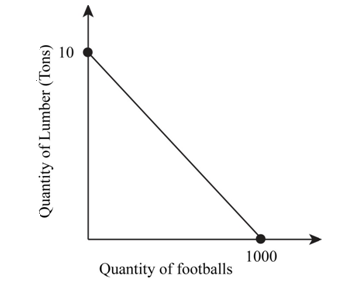
Fig 1
- The above graph shows the PPF of U.S. for the production of footballs and lumber with quantity of footballs on the x-axis and quantity of lumber on the y-axis.
- U.S. can produce maximum 10 tons of lumber with zero production of footballs or 1,000 footballs with zero production of lumber.
PPF of Canada.
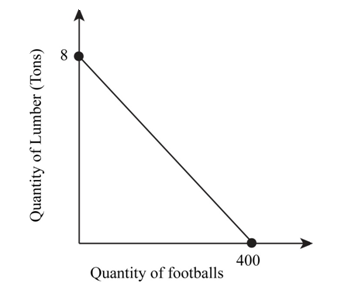
Fig 2
- The above graph shows the PPF of Canada for the production of footballs and lumber with quantity of footballs on the x-axis and quantity of lumber on the y-axis.
- Canada can produce maximum 8 tons of lumber with zero production of footballs or 400 footballs with zero production of lumber.
(b) Consumption of both products in autarky in the given case.
When U.S. consumes 500 footballs.
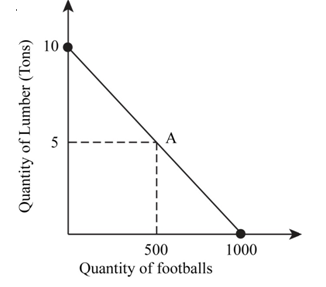
Fig 3
- If U.S. consumes 500 footballs, then in autarky, it can consume 5 tons of lumber as shown in the graph above.
- The quantity of lumber that can be consumed shall be calculated as follows:

When Canada consumes 1 ton of lumber.
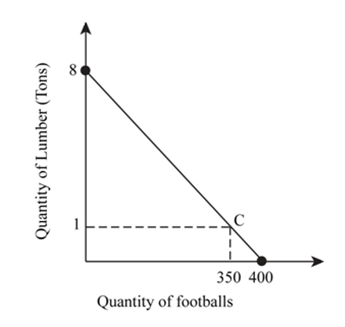
Fig 4
- If Canada consumes 1 ton of lumber, then in autarky, it can consume 350 footballs as shown in the graph above.
- The quantity of football that can be consumed shall be calculated as follows:

Conclusion:
Thus, the quantity consumed of lumber in U.S. is 5 tons and of football in Canada is 350.
(c) Country that has absolute advantage in production of lumber.
- A country is said to have an absolute advantage over the production of a good when it produces higher quantity of that good as compared to the other country.
- In the given case, the maximum quantity of lumber produced by U.S. is 10 tons and by Canada is 8 tons. Hence, U.S. has the absolute advantage over the production of lumber.
Conclusion:
Thus, the U.S. has the absolute advantage in lumber production.
(d) Country that has comparative advantage in production of lumber.
A country is said to have a comparative advantage over production of a good when its opportunity cost to produce that good is less as compared to the other country.
In the given case, if U.S. produces 1 ton of lumber, then it has to sacrifice production of 100 footballs, whereas if Canada produces 1 ton of lumber, then it has to sacrifice production of 50 footballs.
Hence, Canada has a comparative advantage in production of lumber because the opportunity cost of producing 1 ton of lumber is less in Canada than in the U.S.
Conclusion:
Thus, Canada has the comparative advantage in lumber production.
(e) Footballs produced by U.S. and lumber produced by Canada.
U.S. has a comparative advantage in the production of footballs and Canada has a comparative advantage in the production of lumber.
Hence, the maximum quantity of football produced by U.S. for trade is 1,000 and the maximum quantity of lumber produced by Canada for trade is 8 tons.
Conclusion:
Thus, U.S. will produce 1,000 footballs and Canada will produce 8 tons of lumber.
(f) Graphs showing the given situation for U.S. and Canada.
U.S. consumes 500 footballs and 7 tons of lumber.
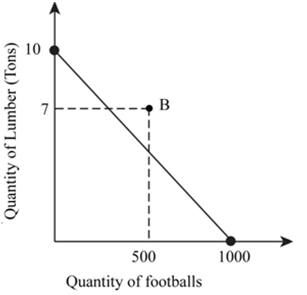
Fig 5
- The graph above shows the point B that denotes 500 footballs and 7 tons of lumber that falls outside the PPF.
- This implies that without international trade, it is not possible for U.S. to consume 500 footballs and 7 tons of lumber simultaneously.
Canada consumes 500 footballs and 1 ton of lumber.
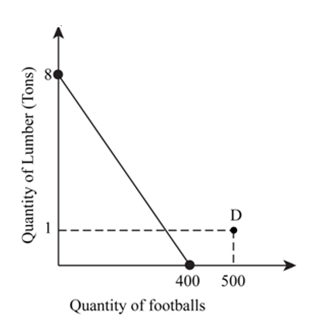
Fig 6
- The graph above shows the point D that denotes 500 footballs and 1 ton of lumber that falls outside the PPF.
- This implies that without international trade, it is not possible for Canada to consume 500 footballs and 1 ton of lumber simultaneously.
Conclusion:
Thus, it is not possible for U.S. and Canada to achieve the given production level without trade.
Want to see more full solutions like this?
Chapter 20 Solutions
ESSENTIALS OF ECONOMICS
- Critically analyse the five (5) characteristics of Ubuntu and provide examples of how they apply to the National Health Insurance (NHI) in South Africa.arrow_forwardCritically analyse the five (5) characteristics of Ubuntu and provide examples of how they apply to the National Health Insurance (NHI) in South Africa.arrow_forwardOutline the nine (9) consumer rights as specified in the Consumer Rights Act in South Africa.arrow_forward
- In what ways could you show the attractiveness of Philippines in the form of videos/campaigns to foreign investors? Cite 10 examples.arrow_forwardExplain the following terms and provide an example for each term: • Corruption • Fraud • Briberyarrow_forwardIn what ways could you show the attractiveness of a country in the form of videos/campaigns?arrow_forward

 Principles of Economics (12th Edition)EconomicsISBN:9780134078779Author:Karl E. Case, Ray C. Fair, Sharon E. OsterPublisher:PEARSON
Principles of Economics (12th Edition)EconomicsISBN:9780134078779Author:Karl E. Case, Ray C. Fair, Sharon E. OsterPublisher:PEARSON Engineering Economy (17th Edition)EconomicsISBN:9780134870069Author:William G. Sullivan, Elin M. Wicks, C. Patrick KoellingPublisher:PEARSON
Engineering Economy (17th Edition)EconomicsISBN:9780134870069Author:William G. Sullivan, Elin M. Wicks, C. Patrick KoellingPublisher:PEARSON Principles of Economics (MindTap Course List)EconomicsISBN:9781305585126Author:N. Gregory MankiwPublisher:Cengage Learning
Principles of Economics (MindTap Course List)EconomicsISBN:9781305585126Author:N. Gregory MankiwPublisher:Cengage Learning Managerial Economics: A Problem Solving ApproachEconomicsISBN:9781337106665Author:Luke M. Froeb, Brian T. McCann, Michael R. Ward, Mike ShorPublisher:Cengage Learning
Managerial Economics: A Problem Solving ApproachEconomicsISBN:9781337106665Author:Luke M. Froeb, Brian T. McCann, Michael R. Ward, Mike ShorPublisher:Cengage Learning Managerial Economics & Business Strategy (Mcgraw-...EconomicsISBN:9781259290619Author:Michael Baye, Jeff PrincePublisher:McGraw-Hill Education
Managerial Economics & Business Strategy (Mcgraw-...EconomicsISBN:9781259290619Author:Michael Baye, Jeff PrincePublisher:McGraw-Hill Education





